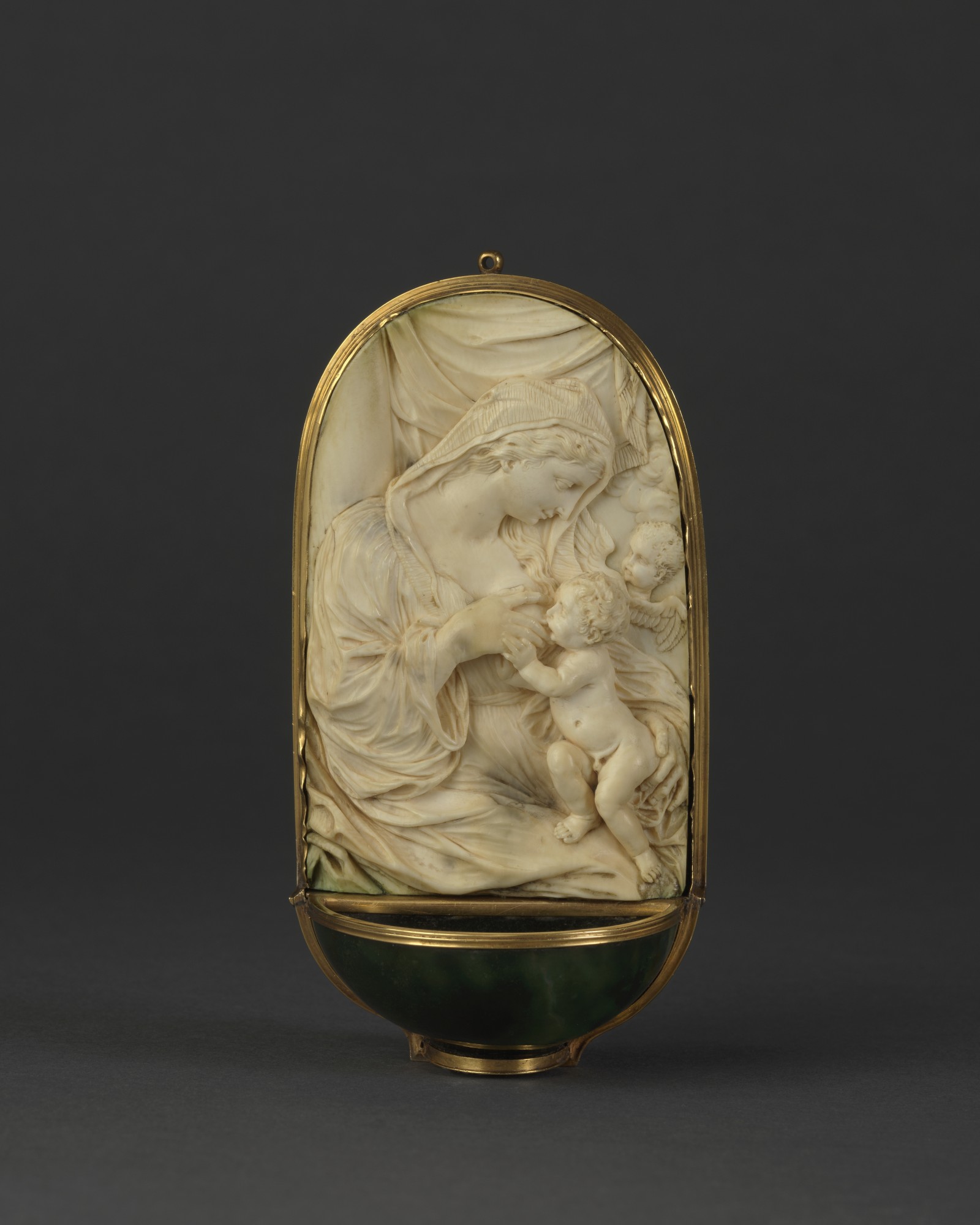


Spitzer Collection, Paris
His sale, 33 rue de Villejust, Paris, 17 April–16 June, 1893, lot 2624
With Blumka II Gallery, New York, 1989
Private collection, The Netherlands
E. Moliner, Les Ivoires: Histoires Générale des Arts Appliqués A L’Industrie (Librairie centrale des beaux-arts, Paris, 1896), p. 235
F. Spitzer (ed.), La collection Spitzer: Antiquité, Moyen Age, Renaissance, Vol. V (Maison Quantin, Librairie centrale des beaux-arts, Paris, 1892), no. 31.
This beautiful ivory relief of Maria Lactans, the Madonna nursing the Christ Child, sits above a deep emerald green bloodstone bowl mounted in gold and designed as a holy water font, commissioned, almost certainly, for private devotion. Of petite proportions, the work is in near perfect condition.
In this intimate portrait, the Virgin sits beneath a fringed canopy, holding her breast to her son, her gaze fixed on him, her left hand cradling his bottom, he positioned on her lap, his feet resting on her right thigh, his tiny right hand placed on hers, his left pressed on her chest, he looks up to his mother. The Virgin wears a veil, her long hair falling down her back and décolletage, the voluminous drapery of her dress with a loose open sleeve, tied with a twist at the waist, reflective of the superb quality of the carving, its fineness seen also in the facial features including those of the angel appearing from the clouds with outstretched feathered wings, the ear and curled locks of the Christ Child and fingernails on his mother’s left hand.
The choice of bloodstone for the bowl is significant. The gemstone, a form of quartz, has long been associated with spiritual power and healing properties. It is sometimes called the ‘Martyr’s Stone’ and medieval christians would carve crucifixes and depictions of martyrs in bloodstone. Legend has it that bloodstone was created when drops of blood fell from the body of Christ onto jasper lying at the foot of the cross. It is therefore thought to be reminiscent of the Saviour's sacrifice.
This extraordinary object has an interesting provenance, having once been part of the collection of the famous, and controversial, 19th century Parisian collector and art dealer Frédéric Spitzer (1815 – 1890). His collection label and seal remain affixed on the lower reverse.
Born in Vienna, according to some reports to a father who was a grave-digger, and following a career in the army, Spitzer bought his first artwork, an engraving by Albrecht Dürer which he later sold for a huge profit, the start of his personal fortune. In 1852 he settled in Paris and became one of Europe’s leading buyers and sellers of art, especially known for his passion for medieval and Renaissance works, collaborating with collectors such as Baron Adolphe de Rothschild and Sir Richard Wallace and sourcing objects from the collections of, among others, Louis Fidel Debruge-Duménil, Prince Soltykoff, Baron Seillière, Alessandro Castellani, and Julien Gréau. By the time of his death in 1890, his private collection was one of the largest and most coveted in Europe. His mansion at 33 rue de Villejust was known as the Musée Spitzer and housed over 4,000 objects.
Near the end of his life, Spitzer persuaded leading art historian Émile Molinier to collaborate with him on a multivolume catalogue of his private collection. Only one volume appeared before Spitzer’s death, but his will left detailed instructions for its completion. Alfred Darcel (1818–1893), who collaborated with Basilevsky, was responsible for the Spitzer ivories.
The Spitzer collection was publicly auctioned in his residence over three months in 1893 with Paul Chevailler and Charles Mannheim presiding. The present font was sold in this sale. In the months before the auction, hailed as the 'Sale of the Century', editorials in American newspapers appealed to institutions and private donors to coordinate to purchase the collection as a whole for a public museum such as the Metropolitan Museum of Art. Despite such pleas, most of the collection was bought by the Australian-born but London-based private collector George Salting (1835 –1909), who bequeathed his collection to the British Museum, the National Gallery in London and the Victoria and Albert Museum. Later, more of Spitzer’s collection was sold in a five session sale at Anderson Galleries in New York (9 –10 January, 1929).
SOLD: Private collection, Belgium